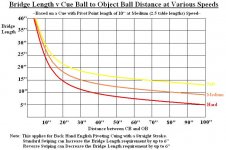After experimenting with a method of dealing with squirt and throw, which I have discussed here a few times recently, I though a few here would like to see a reasonably simple graphic representation of the solution as it currently stands.
You use the graph below by firstly determining the length from Cue Ball to Object Ball, and the degree of Speed which you will play the shot at.
The graph is for my own cue. If you have a low deflection cue, you may need to add a couple of inches to every bridge length, but I think the graph will work quite well for most cues on most shots. If you're out by a few inches, it should only reduce the accuracy by about a degree or so, or 1/4 pocket over 3 feet to the pocket.
For the newbies, how it works is that you line determine the bridge length based on these two variables (which I found are the most critical). Line up the shot as if you're playing it center Cue Ball at medium speed.
Then simply pivot the backhand (backhand english) so that your tip is now aligned to whichever part of the Cue Ball you need to hit to get the english you want. Cue straight along this line.
The reason for all this is because simply BHE pivoting will not work for all speeds and distances. This chart makes an approximation of how to adjust for the variations.
Thanks to Drivermaker and Fred (Cornerman) for harrassing me enough to look more deeply into systems for aiming and compensating, rather than simply guessing or memorizing hundreds of effects.
An important point is the speed adjustment I noted in experiments. This is more than simple reduced throw or swerve effect. The CB definitely squirts more at higher speeds and it is a critical factor in using this type of alignment system for various speed shots.
You use the graph below by firstly determining the length from Cue Ball to Object Ball, and the degree of Speed which you will play the shot at.
The graph is for my own cue. If you have a low deflection cue, you may need to add a couple of inches to every bridge length, but I think the graph will work quite well for most cues on most shots. If you're out by a few inches, it should only reduce the accuracy by about a degree or so, or 1/4 pocket over 3 feet to the pocket.
For the newbies, how it works is that you line determine the bridge length based on these two variables (which I found are the most critical). Line up the shot as if you're playing it center Cue Ball at medium speed.
Then simply pivot the backhand (backhand english) so that your tip is now aligned to whichever part of the Cue Ball you need to hit to get the english you want. Cue straight along this line.
The reason for all this is because simply BHE pivoting will not work for all speeds and distances. This chart makes an approximation of how to adjust for the variations.
Thanks to Drivermaker and Fred (Cornerman) for harrassing me enough to look more deeply into systems for aiming and compensating, rather than simply guessing or memorizing hundreds of effects.
An important point is the speed adjustment I noted in experiments. This is more than simple reduced throw or swerve effect. The CB definitely squirts more at higher speeds and it is a critical factor in using this type of alignment system for various speed shots.
